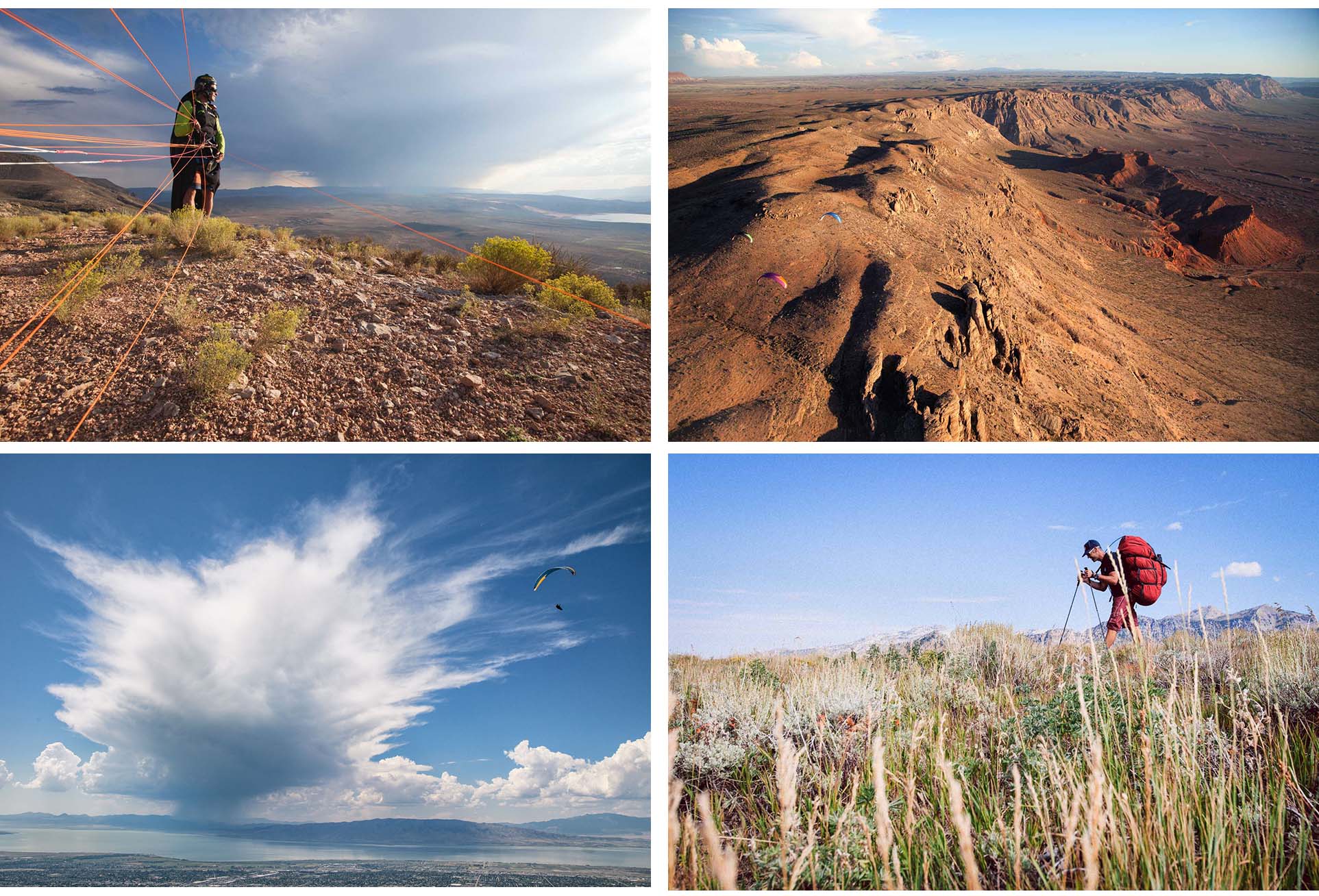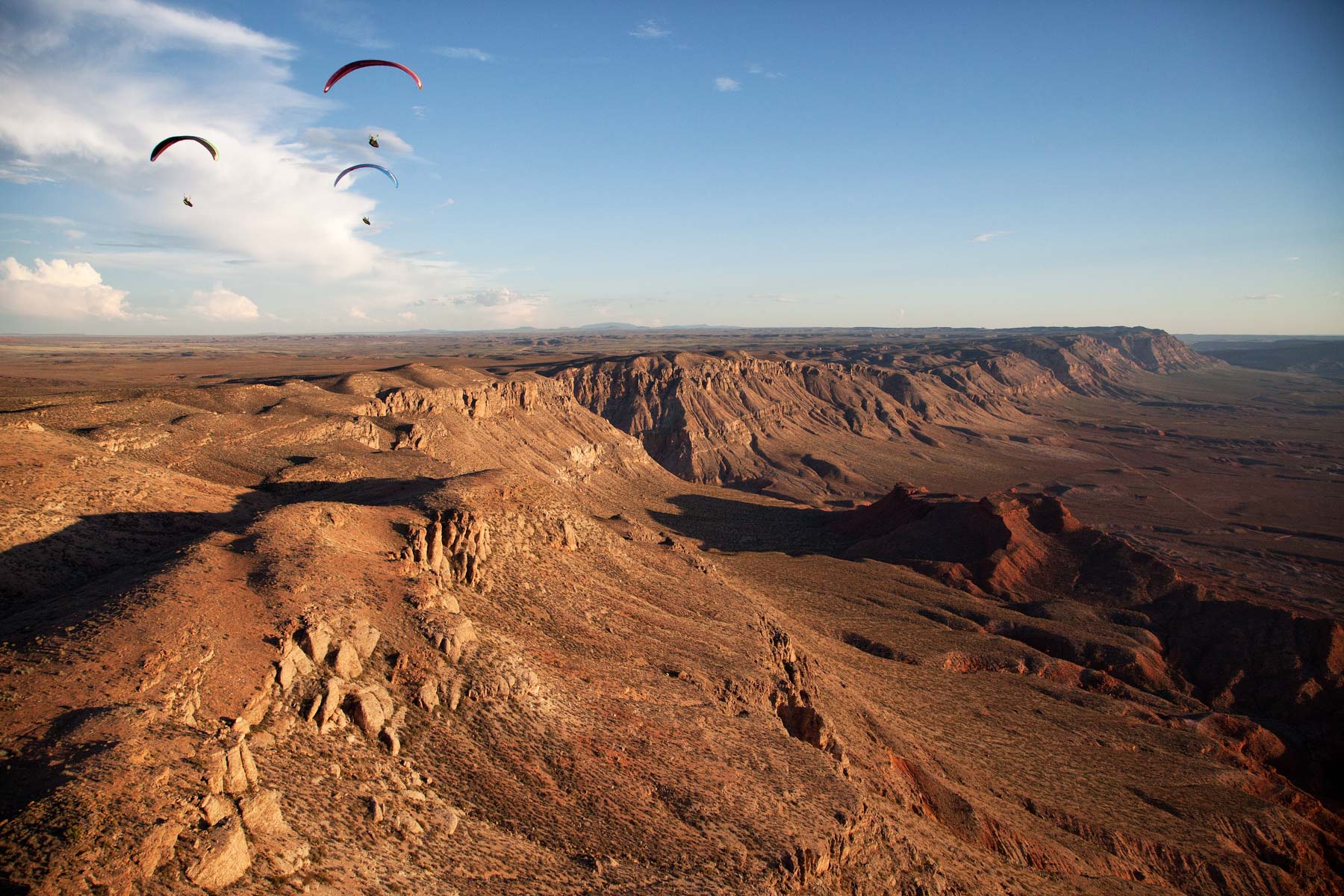Words by Gavin McClurg, Photographs by Jody MacDonald
In my experience successful expeditions always start with good planning. In paragliding there is always an element of winging it (pardon the pun!), and no amount of planning overcomes weather, that uncrossable line in the proverbial sand that dictates our every move, but you can stack the odds in your favor. Looking back I guess we were just cocky, riding the success of last years Sierra Safari, where our team set a distance record for bivvy flying in North America, crossing the California Sierra Mountains from south to north into Oregon. Cocky and paragliding aren’t water and oil, there is no doubt that to perform at a high level you need the right mix of humility and confidence and I felt like our team had an absolutely perfect combination.

Four pilots, each of whom has set the North American foot launch distance in the past year, beginning with Matt Beechinor’s 193 mile punch deep into Montana from Bald Mountain in Sun Valley Idaho which rocked the paragliding world. Followed by Nate Scales pushing even farther into the abyss with a 199 mile flight from the same launch a few weeks later. Not to be outdone, Nick Greece launched from his home site in Jackson Hole just a week later and flew a remarkable 204 miles out over the Red Rock Desert in Wyoming. I then earned my spot on the team by piecing together a 240 mile flight this past summer, breaking the North American foot launch record; and again brought the title back to Sun Valley. These flights weren’t luck, and while some would argue they did have a common factor of phenomenal weather, I would argue that their root lies in a combination of huge wing advancements in the last couple of years, lots and lots of training, and unfiltered desire. Huge flights take a different kind of approach, a different mindset that starts with a willingness to fly into areas without landing options, with enough kit on your back to survive if you can’t get out for a couple days. These are big mountains and “remote” is an inadequate descriptor. I’ve yet to fly a place that requires more commitment, as the world’s best pilots discovered in last years Paragliding World Cup when Guy Anderson, a British pilot disappeared for two days.
Our mission this year was to fly 500 miles in a series of linked flights from southern Utah, near Hurricane Ridge outside of Zion to Jackson Hole across the Wasatch Range and Star Valley. We signed a deal with Outside TV to shoot the trip, brought a bunch of great sponsors on board to provide gear and support and came up with a name: “500 miles to Jackson.” As the title of this article suggests, our mission became something else entirely.

Since its inception, paragliding has always been about chasing weather. This spring I spent 5 weeks in Europe driving across France, Switzerland, Italy and back and then back again in a nearly fruitless pursuit of air-time. Sometimes it’s impossible to run fast enough. The Rocky Mountains run from the southern tip of Chile to the northern tip of Alaska, the longest unbroken chain of mountains on Earth. They stand tall and proud amongst high plains and surrounding deserts that stretch farther than the largest countries in Europe are wide. This geological fact is what makes the flying there intense. Weather is unpredictable. Thermals are vicious. Bases are high, very often well over our legal limit of 18,000 feet. Supplemental oxygen is a necessity. There is no such thing as a perfect flying day. We don’t have “Hammertags”, which literally means “hammer day”, the German term for perfect days in the Alps where pilots have an opportunity to fly really fast with high bases and very little wind. We just have days that are less on the edge than others. Winds come out of nowhere and blow hard. Personally I’ve flown more in the European Alps than at home and I can’t say that flying in the Alps is easier; it’s just an entirely different game. In Europe there are trains and busses to take you home. In the American West there are dirt roads, and a truck might appear once or twice a day. In the Alps pilots fly proven lines and stick to ranges. Up and down the Pinzgau. Up and down the Rhone. Big glides in the Alps are 10 kilometers. At home a normal glide is 20 miles, jumping from one range of mountains to an entirely different one.

These factors are what make bivvy flying in the American West so enticing. Firstly, almost none of the possible lines have been flown. From an aesthetic point of view, the options are almost endless. Our team studied the proposed route across Utah for weeks in advance of the trip, identifying potential top-landing sites and places our retrieve vehicle could get up to us as our Achilles heal is always water. Up high in late August there is no life-sustaining liquid and we could each only carry two days worth on our backs. Our bivvy kit has been much-refined in the last year. We’ve each cut well over 10 pounds of unnecessary equipment, making it possible to fly unmodified pod harnesses instead of a standard harness, which makes us much more efficient in the air.
Our instruments could be charged by the sun thanks to X-Grid’s compact solar kits; sleeping pads are 85% less bulky and heavy thanks to Klymit’s space-age designs; Black Diamond’s trekking poles are strong and hyper-light for morning ascents and tiny bivvy sacs allow for very light-weight sleeping bags; compact and calorie-packed nutrition in the refillable packets that Pocketfuel has smartly engineered. Each of these small but significant improvements saves important ounces, furthering our ability in the air.

But none of this matters in the face of bad weather. We’d chosen late August as this is typically the prime time for reliable flying. The biggest flights are usually done earlier in the year, but instability and wind can often ground pilots for weeks. By late August the monsoon has passed, winds are lighter, the air is more stable and the jet stream has backed off which would hopefully allow us to fly from south to north instead of the typical east (downwind). But when we arrived at Hurricane ridge the monsoon was just arriving. Highly unstable and moisture-rich air was being swept up from the Gulf of Mexico, 1500 miles away and instead of small white puffy cumulus clouds in the afternoon we had massive nimbus clouds and a scary explosion of lightning. Mesmerizing to be sure in the desert: beautiful from the ground, terrifying from the air.

We flew a bit here and there, but inevitably we were forced to run. The forecasts showed drier conditions up north but our paragliders were too slow to get there as we’d planned (in the air) so we modified the expedition at first by 100 miles, driving north. But the weather caught up so we modified it again. 400 miles to Jackson…300 Miles to Jackson… Eventually these modifications became a joke. We were paragliding how it is typically done- driving to launches that held promise and seeing what we could make of the conditions. We kept on north until we did eventually reach Jackson, but unfortunately not by air. We scored a beautiful flight out to the iconic Grand Teton and back, a rarely-flown route of 30 miles in big mountains and then the rain caught up as it had every day and we were grounded again. And that’s when everything changed. Rather than admit defeat and succumbing to the weather we regrouped and realized that while we weren’t living the adventure as we’d imagined, it was still an adventure that should be treasured. Great friends, great flying, and a lot of unknown. So we altered the mission, renamed it to “500 miles to Nowhere” and got back in the truck and drove all the way back to where it all started, at Hurricane Ridge. Where it began all over again…or where it ended all over again. At that point it didn’t matter. We were now on the wings of a proper journey, riding it wherever and at whatever pace the weather dictated.

Maybe it was cocky to even make plans to begin with; our human instincts dictating a course of action that feels comfortable and grounded in reason. I began this essay with the presumption that successful expeditions begin with well-made plans. But essentially we’re flying modified bed sheets and shoe strings with no motor. What we are doing is by definition absolutely unreasonable. So next time, rather than having a predetermined outcome, maybe rather than having a predetermined definition of “success” we can just pack our gliders and our gear and head out there and just see what happens. Because in the end, that’s what happens anyway.

VIDEO



1 thought on “500 Miles to Nowhere”
Comments are closed.